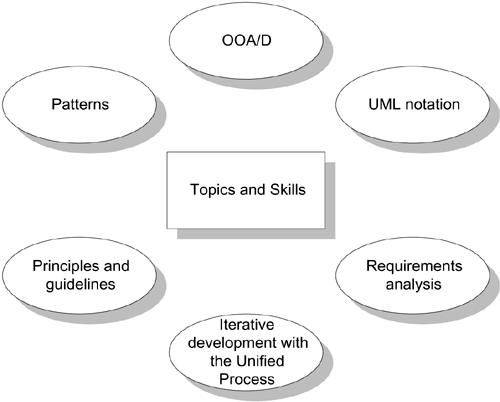1.1. Applying UML and Patterns in OOA/D
What does it mean to have a good object design? This book is a tool to help developers and students learn core skills in object-oriented analysis and design (OOA/D). These skills are essential for the creation of well-designed, robust, and maintainable software using object technologies and languages such as Java, C++, Smalltalk, and C#.
The proverb “owning a hammer doesn't make one an architect” is especially true with respect to object technology. Knowing an object-oriented language (such as Java) is a necessary but insufficient first step to create object systems. Knowing how to “think in objects” is also critical.
This is an introduction
This is an introduction to OOA/D while applying the Unified Modeling Language (UML), patterns, and the Unified Process. It is not meant as an advanced text; it emphasizes mastery of the fundamentals, such as how to assign responsibilities to objects, frequently used UML notation, and common design patterns. At the same time, primarily in later chapters, the material progresses to a few intermediate-level topics, such as framework design.
Applying UML
The book is not just about the UML. The UML is a standard diagramming notation. As useful as it is to learn notation, there are more critical object-oriented things to learn; specifically, how to think in objects—how to design object-oriented systems. The UML is not OOA/D or a method, it is simply notation. It is not so helpful to learn syntactically correct UML diagramming and perhaps a UML CASE tool, but then not be able to create an excellent design, or evaluate and improve an existing one. This is the harder and more valuable skill. Consequently, this book is an introduction to object design.
Yet, one needs a language for OOA/D and “software blueprints,” both as a tool of thought and as a form of communication with others. Therefore, this book explores how to apply the UML in the service of doing OOA/D, and covers frequently used UML notation. But the emphasis is on helping people learn the art and science of building object systems, rather than notation.
Applying patterns and assigning responsibilities
How should responsibilities be allocated to classes of objects? How should objects interact? What classes should do what? These are critical questions in the design of a system. Certain tried-and-true solutions to design problems can be (and have been) expressed as best-practice principles, heuristics, or patterns—named problem-solution formulas that codify exemplary design principles. This book, by teaching how to apply patterns, supports quicker learning and skillful use of these fundamental object design idioms.
One case study
This introduction to OOA/D is illustrated in a single case study that is followed throughout the book, going deep enough into the analysis and design so that some of the gory details of what must be considered and solved in a realistic problem are considered, and solved.
Use cases and requirements analysis
OOA/D (and all software design) is strongly related to the prerequisite activity of requirements analysis, which includes writing use cases. Therefore, the case study begins with an introduction to these topics, even though they are not specifically object-oriented.
An example iterative process—the Unified Process
Given many possible activities from requirements through to implementation, how should a developer or team proceed? Requirements analysis and OOA/D needs to be presented in the context of some development process. In this case, the well-known Unified Process is used as the sample iterative development process within which these topics are introduced. However, the analysis and design topics that are covered are common to many approaches, and learning them in the context of the Unified Process does not invalidate their applicability to other methods.
|
In conclusion, this book helps a student or developer:
It illustrates this in the context of a single case study. |
Figure 1.1. Topics and skills covered

Many Other Skills Are Important
Building software involves myriad skills and steps beyond requirements analysis, OOA/D, and object-oriented programming. For example, usability engineering and user interface design are critical to success; so is database design.
However, this introduction emphasizes OOA/D, and does not attempt to cover all topics in software development. It is one piece of a larger picture.
